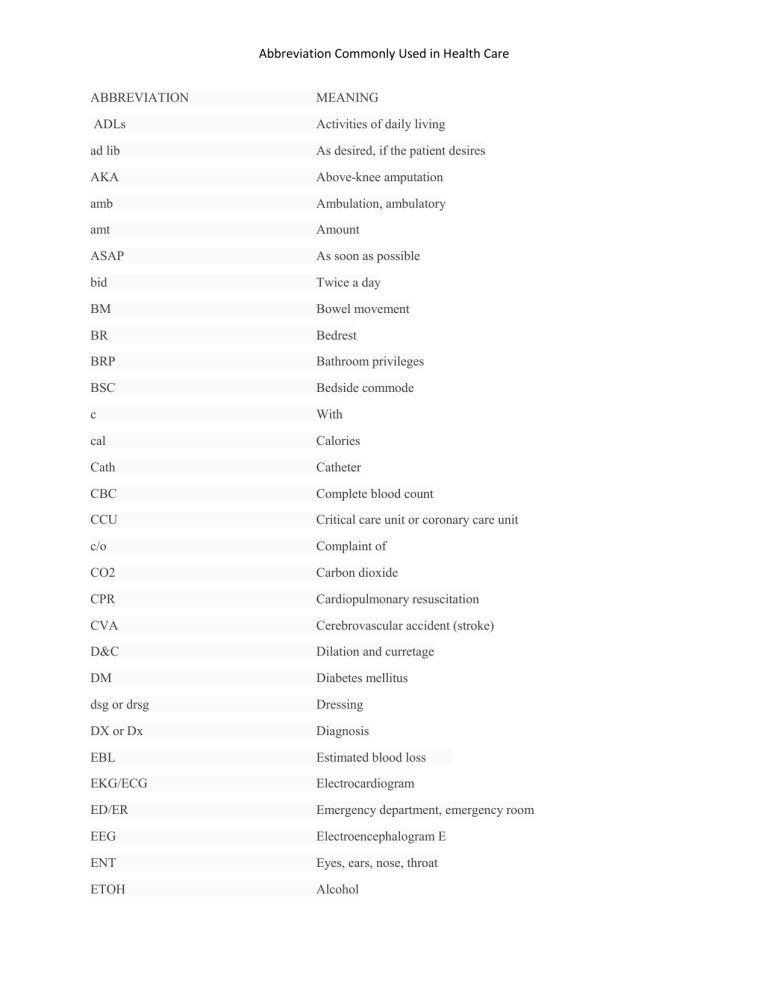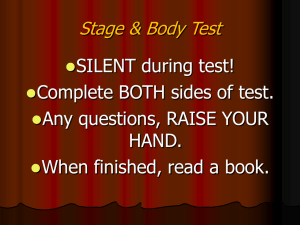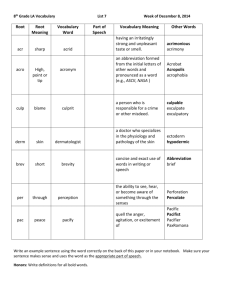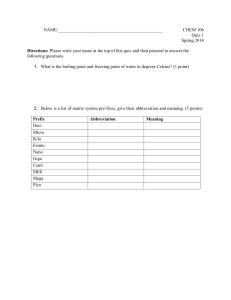
Abbreviation Commonly Used in Health Care ABBREVIATION MEANING ADLs Activities of daily living ad lib As desired, if the patient desires AKA Above-knee amputation amb Ambulation, ambulatory amt Amount ASAP As soon as possible bid Twice a day BM Bowel movement BR Bedrest BRP Bathroom privileges BSC Bedside commode c With cal Calories Cath Catheter CBC Complete blood count CCU Critical care unit or coronary care unit c/o Complaint of CO2 Carbon dioxide CPR Cardiopulmonary resuscitation CVA Cerebrovascular accident (stroke) D&C Dilation and curretage DM Diabetes mellitus dsg or drsg Dressing DX or Dx Diagnosis EBL Estimated blood loss EKG/ECG Electrocardiogram ED/ER Emergency department, emergency room EEG Electroencephalogram E ENT Eyes, ears, nose, throat ETOH Alcohol Abbreviation Commonly Used in Health Care F Female FBS Fasting blood sugar Ft Foot Fx Fracture GI Gastrointestinal gtt(s) Drop(s) GU Genitourinary GYN Gynecology HA Headache HMO Health maintenance organization h/o History of hob or HOB Head of bed HOH Hard of hearing H&P History and physical hr Hour ht Height HTN Hypertension hyper Above or high hypo Below or low ICU Intensive care unit I&O Intake and output isol Isolation IV Intravenous IVP Intravenous push (caution: do not use to mean “IV piggyback”) L Liter lb Pound LPN Licensed practical nurse LMP Last menstrual period LVN Licensed vocational nurse mcg Microgram MD Medical doctor Abbreviation Commonly Used in Health Care med Medication mg Milligram mL Milliliter MN Midnight NAS No added salt N/V/D Nausea, vomiting, diarrhea NKA or NKDA No known allergies or no known drug allergies NG Nasogastric NGT Nasogastric tube noc At night NPO Nothing by mouth O2 Oxygen OB Obstetrics OOB Out of bed OPD Outpatient department ortho Orthopedics OR Operating room os Mouth, opening OT Occupational therapy oz Ounce pc After meals PCA Patient-controlled analgesia PO By mouth P,p After PPBS Postprandial blood sugar prn As needed Pt Patient PT Physical therapy q Every qam Every morning qh Every hour Abbreviation Commonly Used in Health Care qid Four times a day RN Registered nurse R/O Rule out RX or Rx Treatment or prescription s Without SCD Sequential compression device SOB Short of breath ss One-half SSE Soapsuds enema Stat Immediately STI or STD Sexually transmitted infection or sexually transmitted disease TB Tuberculosis TO Telephone order TPR Temperature, pulse, respirations tid Three times a day VO Verbal order VS Vital signs WBC White blood count w/c Wheelchair WNL Within normal limits wt Weight KEY POINT: Abbreviations vary among healthcare agencies. Furthermore, they change rather often because of regulating agency guidelines (e.g., The Joint Commission). Therefore, you will need to be familiar with the abbreviations in the agency in which you work. DO NOT USE THIS ABBREVIATION WRITE OUT THE WORD OR DOSE “U” or “u” Unit “IU” International Unit Q.D., QD, q.d., qd Daily Q.O.D., QOD, q.o.d., qod every other day MS, MSO4, and MgSO4 either morphine sulfate or magnesium sulfate The trailing zero for medications (X.0 mg) X mg (e.g., 10 mg) Abbreviation Commonly Used in Health Care Lack of leading zero (.X mg) 0.X mg (e.g., 0.1 mg) Other Recommendations In consideration of furthering The Joint Commission’s Patient Safety Goals, some institutions require the following to minimize common errors that occur in healthcare organizations: Write out “greater than” or “less than” — rather than using the symbols >or <. Write drug names in full — rather than using abbreviations. Use metric units — instead of apothecary units. Write “at” or “each” — rather than use the @ symbol. Write “mL” or “milliliters” — in place of the “cc” abbreviation. Write “mcg” or “micrograms” — instead of the “µg” abbreviation.


